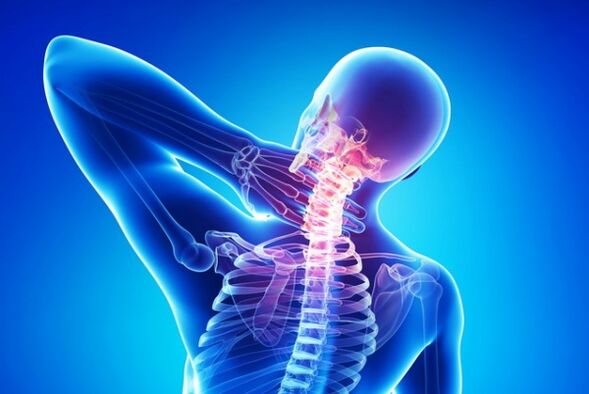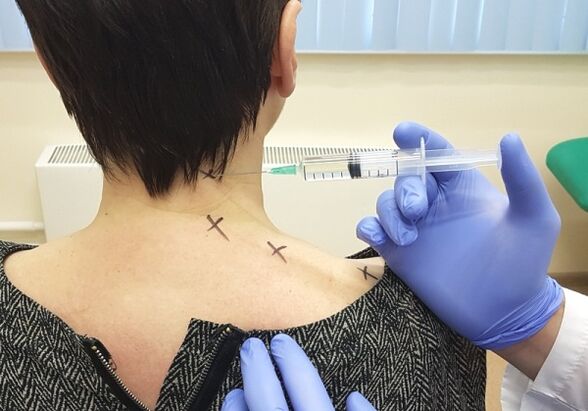The osteochondrosis of the cervical column is one of the ordinary osteochondosis varieties. It manifests itself for degenerative destruction of adjacent records and vertebrae. At the same time, arteries and nerve endings are designed in the pathological process. Recently, cervical osteochondosis has become much younger. If in the last century the disease was the lot of the elderly, today the young people of 23-40 years suffer from it, perhaps older. This dystrophy represents up to 40% of the total number of patients.

Reasons
Why is cervical osteochondosis develop? It has been shown that the most common cause of the pathology is the lack of active movements. Sit the work with an extended neck forward or an arched head: this is how the working day of the employees and representatives of many other specialties passes. Arriving at home, the majority is again for a computer or TV. A similar way of life leads to a deterioration of the blood flow in the spinal artery, followed by the disk dystrophy and the destruction of the vertebrae. The factor considered is far from the only guilty of the disease. There are other causes of cervical osteochondrosis. For example, many experts attribute great importance to the hypothermia and hereditary weakness of the joints, ligaments and intervertebral muscles. The following factors become the starting mechanism for the development of osteochondosis of the neck:
- disorders in the work of the endocrine system;
- flat feet;
- spine injuries;
- violation of posture;
- unbalanced diet;
- high load on the cervical segment;
- autoimmune diseases;
- Viruses and infections.
In women of the postmenopausal period, the cause of the progressive dystrophy of the cervical column is a decrease in the production of estrogen with concomitant development of osteoporosis.
Symptoms
The symptoms of osteocondrosis may appear both at the beginning of the disease and later, in the chronic phase. It all depends on the degree of dystrophy, the presence of concomitant pathologies and a combination of adverse conditions. The main symptoms of osteochondosis of the cervical column:
- Hell on the bench;
- migraine, dizziness;
- neurotic disorders;
- pain and creak in the neck;
- The weakness of the upper limbs:
- compromised sensitivity;
- worsening of hearing and vision, disorder of the coordination of movements;
- Loss of performance.
The pain for cervical osteochondosis can give everywhere: in the shoulder, in the elbow, in the ear, under the scapula. A distinctive feature of unpleasant sensations is a surprise. In an acute attack, the discomfort unexpectedly disappears as it occurs. The dizziness for osteochondosis of the neck are often accompanied by disorientation, a sound in the ears, loss of consciousness, nausea, migraine. Overdue occur several times a day and are scarcely lent to medical correction. The symptoms of damage to the cervical vertebrae that occur in the brain are based on the deterioration of the blood flow and the trophism of the tissues. As a result of the compression of the spinal artery and the hunger for oxygen in patients, the following disorders are manifested:
- a sense of fear and panic;
- irritability;
- aggression;
- frequent change of mood;
- tears;
- insomnia;
- worsen memory and attention;
- Unreasonable outbreaks of anger.
The signs of cervical osteochondosis in women appear in some way before in men and proceed more pronounced. The first symptoms of diseases, as a rule, are brain disorders, often that they are deleted on a PMS or hormonal failure. Then there are dizziness, migraines, loss of consciousness. The symptoms of cervical osteocondrosis in men do not occur so intensely and often resemble an attack by Angina pectis with concomitant lack of breath, nausea, discomfort behind the sternum. Only a specialist can determine the real cause of these events, he will be able to provide primary assistance, therefore he should not be delayed with his visit.
Grade
Considering and analyzing the procedure for the development of changes in the vertebra tissues, the doctors have designated several phases of osteochondosis of the cervical region:
- Clinical phase. The cervical osteochondosis of the 1st degree is expressed by the movement of the octopus nucleus on the side and from the beginning of the destruction of the fibrous ring. Pain in this period can be absent, a small lordosis is possible and difficulty turning or tilting the head.
- The osteochondrosis of the 2nd degree cervical region is characterized by an increase in pathological destruction, the instability of the entire segment with subupon and a pain appears, sometimes giving in to the belt or arm. The patient complains of distraction, a deterioration of memory and attention.
- The osteochondrosis of the 3rd degree develops with a complete breakdown of the fibrous ring. They look like neurological symptoms, sensitivity is disturbed. The pain in the third phase becomes constant and greatly disturbs the patient. The mobility of the cervical segment worsens.
- Osteochondrosis of the neck of 4 degrees. The final phase of the degenerative process. The intervertebral disc is completely replaced by the connective tissue, all symptoms become more pronounced, a deterioration of the coordination of movements, ataxia.

Depending on the location of pain, the following type of disease is distinguished: and cervical. According to the method, of course, the disease is customary to divide into acute intervertebral osteochondous of the neck, which appears for the first time and chronic, extends for years with constant remissions and exacerbations.
Which doctor treats cervical osteochondrosis?
The variety of symptoms, which often hides under the mask of another disorder, causes patients to be a logical question: which doctor contact? When any pain in the neck, shoulders and hands or the occurrence of neurotic disorders, it is urgent to approach the neurologist. And who to contact if there are no specialists in the local clinic? In this case, the ticket should be postponed to the therapist. The doctor will prescribe the treatment or send a narrow specialization to the doctor.
Diagnostics
The diagnosis of cervical osteochondosis begins with a visual examination and a patient survey. The neuropathologist is interested in the conditions of the life and work of the patient, in the presence of chronic disorders, nutrition and motor activity. A preliminary diagnosis is confirmed by the conduct of the instrumental research:
- X -Reggi in two projections;
- MRI;
- Ct;
- Duplex scan.
Hormone analysis is required for the right sex. Without it, the treatment of cervical osteocondrosis in women does not start. To exclude pathologies with these symptoms, a differential diagnosis is carried out with the appointment of further consultations with a surgeon, gynecologist, cardiologist, ophthalmologist and tradition.
Treatment
First aid for acute pain in the cervical segment includes the intake of anesthetics and the guarantee of the rest of the affected area. Distraction therapy: pepper patch, apply heating ointments helps well. However, these measures are unable to cope with the disease. They only temporarily facilitate the patient's condition. The treatment for osteochondrosis of the cervical column is complete. Its main objective is to eliminate pain and slow down the destruction of records and vertebrae. For this, various types of therapy are prescribed: medicines, therapy for exercises, massage, wearing an orthopedic collar. The treatment of cervical osteochondrosis in women has a series of characteristics and is mainly aimed at eliminating symptoms that occur in the brain. Another effective remedy for neck pain is physiotherapy. The treatment is prescribed both during the exacerbation and during remission. The following procedures face the symptoms of osteochondrosis:
- laser;
- magnetotherapy;
- ultrasound;
- Electrophoresis with Novocaine or Eufillin.
Murgly facilitates the condition of patients with therapeutic massage. Perform it only in the remission phase. To obtain a persistent result, the therapy is carried out by a course composed of 9-10 procedures. Healing gymnastics is very effective for osteochondosis of the cervical region. The strictly dosed load quickly eliminates discomfort, improves vertebral mobility, strengthens muscles and improves blood flow. Often patients with osteochondrosis turn to recipes for traditional medicine, hoping for a cure. It should be remembered that all non -traditional agents are eligible only as addition to the main therapy prescribed by the doctor. Is it possible to completely cure cervical osteochondrosis? Unfortunately not. Drugs and other conservative methods can only suspend the dystrophic process and eliminate symptoms. Even after satisfactory therapy, the records concerned are still replaced by the connective tissue and lose their functionality.
Complications
The osteochondrosis of the cervical column is dangerous with its complications. With the development of the disease, squeezing the spinal artery can cause a brain stroke, the persistent worsening of hearing and vision. Often, an hernia, a serious hypertension and an numbness or cooling of the fingers come together with osteochondosis. In women, complications of neurological nature are often developed: constant fatigue, lethargy, loss of performance, excessive resentment.
Prevention

The prevention of the osteocondrosis of the cervical column includes physical activity at affordable prices, a balanced diet with a sufficient amount of calcium and phosphorus, weight control and maintaining the correct posture. Everything above should become a habit and rigorously satisfied, better from early childhood. Employees and those who spend many hours behind the monitor screen to prevent osteochondosis of the neck should adhere to simple recommendations:
- Each hour it organizes 10 -minute breaks during which they perform simple exercises;
- At lunchtime, do not sit in the workplace, but take a walk in the fresh air;
- Choose comfortable production furniture that exclude an uncomfortable pose;
- Organize a good table light.
After a day of work, it is recommended to lie on a flat surface without a pillow for 15-20 minutes or ask the family to make a light massage. This will help to relieve the tension of the cervical muscles and relax. The excellent prevention of degenerative changes will not be traumatic sport and swimming. Osteochondosis identified and well -kept on the cervical region may not manifest itself for many years, allowing the patient to conduct a completely comfortable life. And with a regular preventive administration used for the prevention and treatment of drugs of drugs, the disease will cease to disturb even in old age.




















